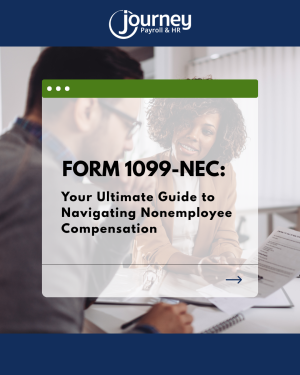Whether you’re a business owner paying contractors or a freelancer invoicing clients, Form 1099-NEC is an essential tool for reporting non-employee income to the IRS. The rules have recently changed, thanks to the newly passed “Big Beautiful Bill,” so it’s important to understand the updates. Journey Payroll & HR is here to break down what you need to know.
 What Is Form 1099-NEC?
What Is Form 1099-NEC?
Form 1099-NEC, short for Nonemployee Compensation, is used to report payments made to individuals who aren’t employees, such as independent contractors, freelancers, gig workers, and consultants. Traditionally, if you paid $600 or more to a non-employee for services throughout the year, you were required to file this form.
Big Change: 1099-NEC Threshold Increases
Thanks to recent legislative updates, starting with payments made on or after January 1, 2026, the 1099-NEC filing threshold is increasing from $600 to $2,000.
What This Means:
- For payments in 2025, the $600 rule still applies.
- For payments in 2026 and beyond, you will only need to issue a 1099-NEC if you pay $2,000 or more to a contractor during the tax year.
This change is designed to reduce administrative burdens for small businesses and freelancers by limiting unnecessary filings.
Quick History Lesson: Why the Shift from 1099-MISC to 1099-NEC?
Before 2020, non-employee compensation was reported in Box 7 of the 1099-MISC form. To simplify filing deadlines and reduce confusion, the IRS reinstated the 1099-NEC as a separate form solely for non-employee payments. The 1099-MISC now covers other types of payments such as rent, prizes, legal settlements, and royalty payments, while the 1099-NEC is strictly for service-based payments.
Who Needs to File Form 1099-NEC?
You are required to file Form 1099-NEC if:
- You paid someone who is not your employee,
- The payment was for business-related services,
- You paid an individual, partnership, or LLC, or in certain cases, a corporation (such as for attorney fees or healthcare services),
- You paid $600 or more (or $2,000 starting in 2026) during the calendar year,
- Or you withheld federal taxes under backup withholding rules, regardless of payment amount.
Important Deadlines You Can’t Ignore
The deadline to file Form 1099-NEC with the IRS and provide a copy to your contractor is January 31.
If January 31 falls on a weekend or holiday, the deadline moves to the next business day.
Penalties for Missing the Deadline
Late filings result in penalties ranging from $50 to $280 per form, depending on how late the submission is. If the IRS determines that the filing was intentionally disregarded, the penalties are significantly higher. Filing on time is the most effective way to avoid these penalties and maintain compliance.
Update on 1099-K: Reporting Threshold Change
The previously proposed $600 threshold for 1099-K reporting (which applies to payment processors such as Venmo, PayPal, Cash App, Stripe, Square, and Etsy) has been repealed.
The reporting threshold has reverted to:
- $20,000 and 200 transactions per year to trigger a 1099-K issuance.
This means smaller, casual transactions through payment apps are not subject to 1099-K reporting.
State Filing Requirements
Unlike the 1099-MISC, the 1099-NEC is not included in the IRS’s Combined Federal/State Filing Program. If your state has an income tax, you may be required to file a separate state return. Always review your state’s specific filing requirements or allow Journey Payroll & HR to assist.
Why This Matters
These updates offer relief to businesses, freelancers, and payment platforms by:
- Reducing administrative paperwork,
- Increasing thresholds to prevent low-dollar filings,
- Providing clearer and more consistent reporting guidelines.
By partnering with Journey Payroll & HR, businesses can stay compliant and operate more efficiently without the added stress of tracking complex filing rules.
If you need support with contractor payments or navigating these updated requirements, contact Journey Payroll & HR for professional payroll and tax compliance services.